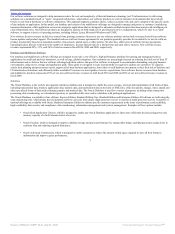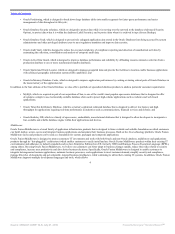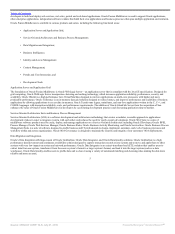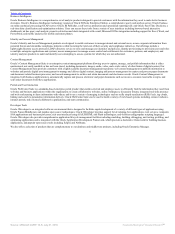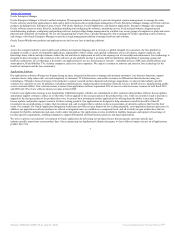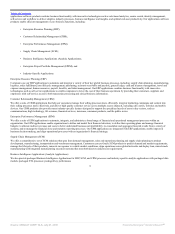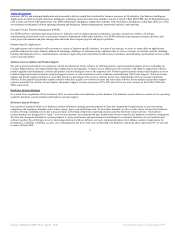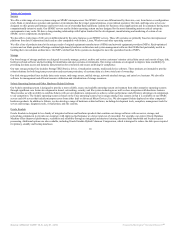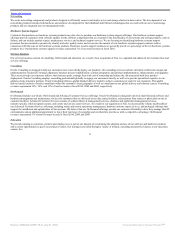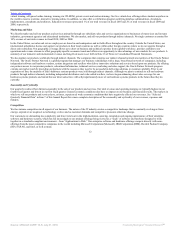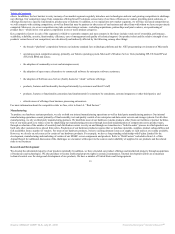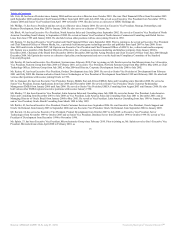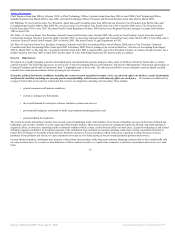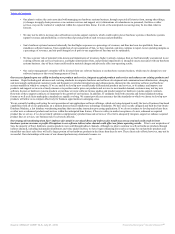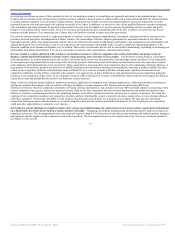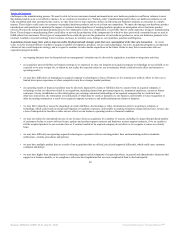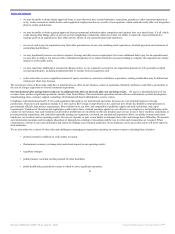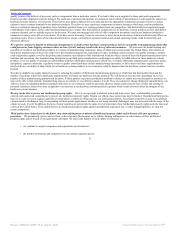Oracle 2009 Annual Report Download - page 17
Download and view the complete annual report
Please find page 17 of the 2009 Oracle annual report below. You can navigate through the pages in the report by either clicking on the pages listed below, or by using the keyword search tool below to find specific information within the annual report.
Table of Contents
others. In addition, the low barriers to entry in many of our market segments regularly introduce new technologies and new and growing competitors to challenge
our offerings. Our competitors range from companies offering broad IT solutions across many of our lines of business to vendors providing point solutions, or
offerings focused on a specific functionality, product area or industry. In addition, as we expand into new market segments, we will face increased competition as
we will compete with existing competitors, as well as firms that may be partners in other areas of our business and other firms with whom we have not previously
competed. Moreover, we or our competitors may take certain strategic actions—including acquisitions, partnerships and joint ventures, or repositioning of
product lines—which invite even greater competition in one or more product categories.
Key competitive factors in each of the segments in which we currently compete and may compete in the future include: total cost of ownership, performance,
scalability, reliability, security, functionality, efficiency, ease of management and quality of technical support. Our product sales (and the relative strength of our
products versus those of our competitors) are also directly and indirectly affected by the following, among other things:
• the broader “platform” competition between our industry standard Java technology platform and the .NET programming environment of Microsoft;
• operating system competition among, primarily, our Solaris operating system, Microsoft’s Windows Server, Unix (including HP-UX from HP and
AIX from IBM) and Linux;
• the adoption of commodity servers and microprocessors;
• the adoption of open source alternatives to commercial software by enterprise software customers;
• the adoption of Software-as-a-Service (SaaS), hosted or “cloud” software offerings;
• products, features and functionality developed internally by customers and their IT staff;
• products, features or functionality customized and implemented for customers by consultants, systems integrators or other third parties; and
• attractiveness of offerings from business processing outsourcers.
For more information about the competitive risks we face, refer to Item 1A. “Risk Factors.”
Manufacturing
To produce our hardware systems products, we rely on both our internal manufacturing operations as well as third party manufacturing partners. Our internal
manufacturing operations consist primarily of final assembly, test and quality control of our enterprise and data center servers and storage systems. For all other
manufacturing, we rely on third party manufacturing partners. We distribute most of our hardware systems products either from our facilities or partner facilities.
One of our main goals is to reduce costs by simplifying our manufacturing processes through increased standardization of components across product types,
through a reduction of the number of assembly and distribution centers we rely on and through our transition to a “build-to-order” process in which products are
built only after customers have placed firm orders. Production of our hardware products requires that we purchase materials, supplies, product subassemblies and
full assemblies from a number of vendors. For most of our hardware products, we have existing alternate sources of supply or such sources are readily available.
However, we do rely on sole sources for certain of our hardware products. For example, we have a long-standing relationship with Fujitsu Limited for the
development, manufacturing and marketing of certain of our SPARC server components and products. Refer to “Risk Factors” included in Item 1A. of this
Annual Report for additional discussion of the challenges we encounter with respect to the sources and availability of supplies for our products and the related
risks to our business.
Research and Development
We develop the substantial majority of our products internally. In addition, we have extended our product offerings and intellectual property through acquisitions
of businesses and technologies. We also purchase or license intellectual property rights in certain circumstances. Internal development allows us to maintain
technical control over the design and development of our products. We have a number of United States and foreign patents
13
Source: ORACLE CORP, 10-K, July 01, 2010 Powered by Morningstar® Document Research℠


